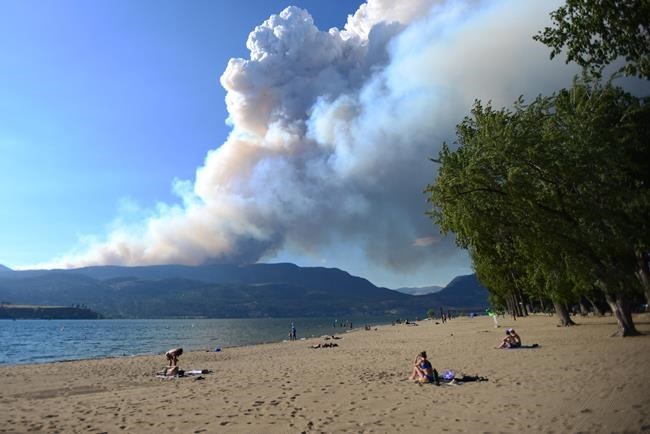West Kelowna resident Heather MacKay watched her home burn via an interior security camera about two weeks ago as the property was engulfed by wildfire.
She said she watched the smoke spread and "could hear the flames popping".
MacKay said it was a devastating moment. But she's now feeling hopeful that the wildfire she likened to an "apocalypse" may be coming to an end.
Two of the three fires making up the Grouse wildfire complex that destroyed almost 200 homes around Lake Okanagan in the B.C. Interior — Mackay's among them — are now under control.
However, the BC Wildfire Service says the region's most destructive fire, the McDougall Creek blaze in West Kelowna, continues to defy suppression efforts.
"It's been really dark and dreary, but I will say as the fires are getting under control, and while ours (the McDougall Creek fire) is not under control yet, things are lightening up a bit and we're feeling hope because the skies are only smoky now," MacKay said. "They're not black anymore."
The Grouse complex that forced thousands of people to evacuate has been a key front in B.C.'s worst wildfire season on record since the McDougall Creek fire swept down on West Kelowna on Aug. 17, setting neighbourhoods ablaze.
The Lake Country and Clifton-McKinley fires on the east side of Lake Okanagan then sprang to life, threatening the City of Kelowna and properties to the north.
The Central Okanagan emergency operations centre said late Thursday that although those two fires are now under control, evacuation alerts remain in place, and residents need to be ready to leave on short notice.
The 137-square-kilometre McDougall Creek fire is still "actively burning" on its west and southwest flanks, the wildfire service said Friday.
It's too soon for many people impacted by the McDougall Creek fire to go back, even if their homes still stand. The wildfire service said 463 properties are under evacuation order, with 20,053 properties under evacuation alert.
However, the Central Okanagan EOC is organizing bus trips for people whose homes were destroyed. It has said people invited on the tours must remain on the bus during their visit.
Mackay — whose family has been staying with relatives in Peachland, but has secured a rental in Kelowna for October — said she has not yet been contacted about a bus tour, but has no intention of taking part.
"If we were able to stop and walk around our properties, I'd be the first one on the bus, but because they're just doing a drive by it, I think it'd be too emotional and too heavy," she said.
A tour might be beneficial to those uncertain of whether their properties have been destroyed, she said. But that isn't her family.
"We already know there's nothing there," she said. "We're just waiting until we can go and see if we can find any treasures."
Firefighters are warning residents in northern B.C. that forecast high winds are likely to feed the growth of wildfires over the next two days.
The wildfire service says it is "anticipating increased fire behaviour" in the Northwest and Prince George fire centres — encompassing the northern half of the province — from Friday into Saturday.
Environment Canada has issued a weather advisory this morning stretching from B.C.'s Peace River region including Fort St. John and Dawson Creek to Fort Nelson and areas further to the northwest such as Cassiar and Watson Lake, Yukon.
The advisory says winds from the west and southwest are likely to reach 40 kilometres an hour over the next two days, and gusts may reach 60 kilometres an hour.
Environment Canada says the high winds will likely "worsen wildfire conditions" as well as contribute to deteriorating air quality as they drive smoke from nearby blazes.
Further south, wet and cool weather has helped fire crews in the southern Interior of B.C. this week, with rainfall in the Fraser Canyon and Shuswap regions, as well as Central Okanagan, helping firefighters.
Officials say it has helped crews contain several major fires such as Kookipi Creek south of Lytton from further growth.
The Regional District of Okanagan-Similkameen said Friday that its Emergency Operations Centre had conducted aerial assessments. It has begun notifying owners of damaged or destroyed buildings along Ashnola Road and Ewart Creek Road, but did not say how many structures were impacted.
On Thursday, provincial Emergency Management Minister Bowinn Ma extended B.C.'s state of emergency until Sept. 14 and said drought conditions may last into next year.
There were 417 active wildfires burning in British Columbia on Friday afternoon, with about 184 listed as out-of-control, and 12 described as "wildfires of note," meaning they are highly visible or pose a potential threat to the public.
About 4,200 people in the province remain on evacuation orders, with another 65,000 on alert to be ready to evacuate on short notice.
This report by The Canadian Press was first published Sept. 1, 2023.
Brieanna Charlebois, The Canadian Press



